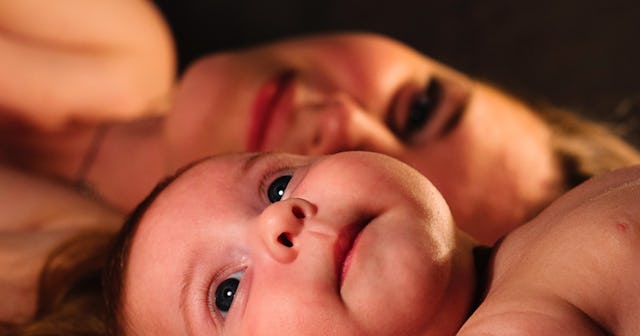How To Do Skin-to-Skin Contact So Baby Can Reap The Benefits Of Your Closeness

To those who aren’t that familiar with the sometimes weird world of parenting, certain practices that are considered totally normal — or even the “correct” thing to do in a situation — can look a little odd. Everyone’s used to seeing the delivery room photos of an exhausted-yet-blissed-out new mom holding her baby, as well as ones of the newborn wrapped in swaddling clothes and wearing some sort of hat or headband. Then, at some point, a new shot was added to the mix, featuring a shirtless dad holding the baby against his chest.
While we could see these intimate moments being turned into a calendar (dad bods year-round FTW), what you’re actually looking at is some skin-to-skin contact in action. And it’s not something that should end once the baby leaves the hospital: It’s an important part of bonding and helping baby adjust to life outside the womb. Here’s what to know about skin-to-skin contact for babies, including the benefits, and how to do it.
What is skin-to-skin contact?
Before we get into the instructions, let’s take a look at the history of this practice and some of the benefits of skin-to-skin contact for babies.
In the 1970s, two physicians in South America ran out of incubators to adequately care for premature babies in their hospital. So, what did they do? They decided to place the teeny-tiny babies directly on their mamas’ bodies. Their thought was that mama’s body would warm the baby. And, well, it worked! The babies thrived, and their bright idea became a celebrated method.
Today, at a time when there is SO much baby gear out there — each piece more complicated and expensive than the next — it can be hard to wrap your head around the fact that something as simple as skin-to-skin contact with a baby can have such a big impact on their well-being (and yours too!).
What does skin-to-skin do?
There is a growing body of scientific evidence showing what skin-to-skin contact — also referred to as the “kangaroo mother method” or “kangaroo care” — can do for a baby. This includes stimulating a certain part of a newborn’s brain, assisting with their emotional and social development, body temperature regulation, and improving their general health. Here are some specific examples of benefits a baby gets from skin-to-skin contact:
- Assisting digestion and nutrient absorption
- Maintaining a healthy body temperature
- Crying less often
- Enabling colonization of the baby’s skin with the mother’s friendly bacteria, thus providing protection against infection
- Improved weight gain
- A more stable heartbeat and breathing
- Higher blood oxygen levels
- More successful at breastfeeding immediately after birth
- Spending more time in the very important deep sleep and quiet alert states
- Regulation of blood sugar
- Easier transition from the womb to the outside world
- Pain relief
- Enhanced bonding with baby
There are also benefits for moms, including having a reduced risk of postpartum bleeding and postpartum depression, as well as a better breastfeeding experience (if that’s happening).
How do you do skin-to-skin with a newborn?
It sounds simple — and for the most part, is — but skin-to-skin contact involves a little more effort than just plopping (sorry, resting) your baby against your bare bosom. The first skin-to-skin contact typically happens immediately after birth. It will likely go something like this:
- A health care provider will dry the baby off and place them belly-down on the mother’s (or a partner’s) chest.
- The health care provider may help the little one get settled by placing a blanket over their exposed back.
- You then snuggle with your little nugget for a few hours (as long as the experience isn’t too overwhelming for new moms).
Anytime you or a partner engages in skin-to-skin contact with a baby, make sure the baby’s face is turned sideways, in a position that keeps their airway open.
How long should you do skin-to-skin?
The skin-to-skin bonding shouldn’t end when the baby checks out of your uterus and you all check out of the hospital. Keep doing it at home! Here are some tips for making that happen:
- Avoid changing the baby’s diaper or anything else that might upset them before you start the skin-to-skin snuggles.
- Work it into your daily routine at home during feedings, particularly first thing in the morning, or right after they take a bath.
- Aim to stay in the skin-to-skin position for an hour, so the baby has a chance to go through a full sleep and wake cycle.
There’s no set schedule for stopping regular skin-to-skin contact, but some doctors recommend keeping it up for at least three months for full-term babies, and six months for preemies.
Should dads do skin-to-skin?
And now, back to those topless dad delivery room photos. As you’ve probably gathered, there are plenty of benefits for both father and baby from the bare-chested snuggle sessions, including increased emotional intimacy, keeping the baby warm and comfy, and giving the dad more confidence as a parent. It can also reduce stress and anxiety in dads, which is a benefit for everyone, really.
This article was originally published on